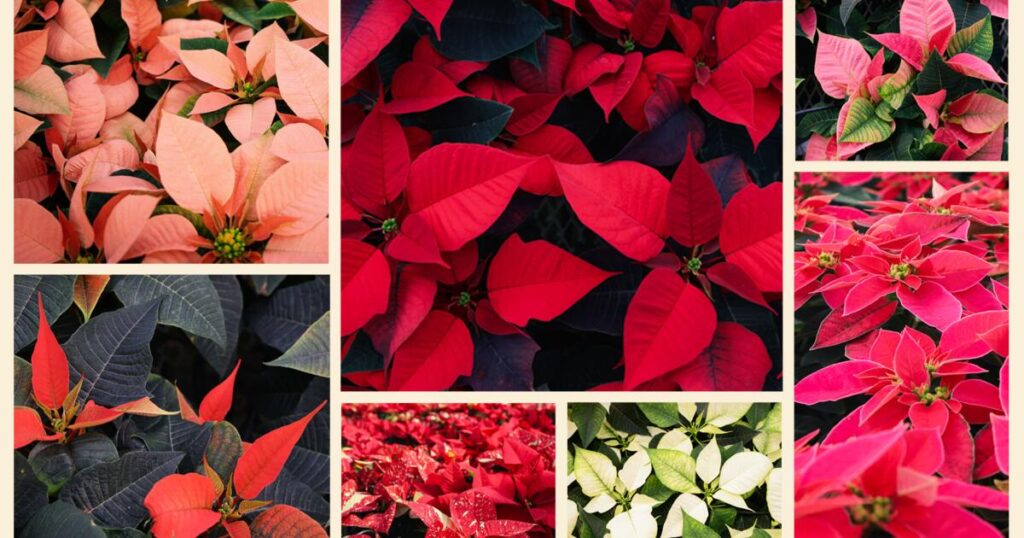Tired of the same old, same old when it comes to holiday decor? How about a Dream House-themed Christmas, with poinsettias so vividly pink they would make Barbie swoon?
Too much?
Then what about a selection of poinsettias — the country’s top-selling potted flowering plant — in eye-popping colors? There are bright whites, luscious creams, a glowing yellow, velvety autumnal oranges, a demure peach and novelty varieties speckled with dots or swirled with hues so intense they could stand as props in a Renaissance still life.
Still not right? Well, not to worry. Starting this week, Weidner’s Gardens in Encinitas is offering 25 kinds of poinsettias in myriad shapes, sizes and colors, including 10 scarlet varieties that should satisfy the most die-hard of traditionalists in shades of ruby and bright crimson or reds that pop against purplish leaves, curl like fat wrinkled ribbons or crown the tops of shrubs pruned into mini trees.
There’s also a petite variety in a 2-inch pot designed to enliven an office desk without taking up too much space.
“Our business is color — we’re color growers,” said Kalim Owens, who co-owns the 52-year-old nursery with his friend and business partner Oliver Storm. “Our founders, Evelyn and Bob Weidner, specialized in growing begonias, then fuchsias and impatiens and on from there. We’re a full-service nursery; we also sell fruit trees and vegetables. But our specialty is flowers.”
Poinsettias, it turns out, are the highest-revenue plants they grow, despite a sales window of just six weeks. With sales like that, no wonder poinsettia promoters have been trying for decades to develop colors and varieties people will buy year-round.
But here’s the rub: The Ecke farming family, who grew and promoted poinsettias into a holiday staple, did their job too well.
“Poinsettias are so strongly connected to the Christmas season, it’s hard to get people to break that mold,” said Ruth Kobayashi, who has been breeding poinsettias and other flowers in Encinitas for some 30 years, first for Ecke Ranch and then for Dümmen Orange, one of the world’s largest breeders and propagators of ornamental plants.
Kobayashi created the electric pink variety (named Lov U Pink) to bedeck homes at Easter the way red poinsettias do at Christmas. Also, there were similar hopes that Winter Rose (the curly red poinsettia bred to resemble a clutch of roses) would become a popular gift for Valentine’s Day.
“But it didn’t work,” said Weidner’s co-owner Storm. A bouquet of red roses “will be dead within a week, while this,” — he gently shook a pot of plump Winter Rose blooms — “will still be there, happy as a clam. But people looked at the plant and said, ‘Oh, that’s a poinsettia,’ and walked on. They just can’t let go of the idea that poinsettias are for Christmas.”
Nonetheless, Weidner’s prides itself on its floral diversity. It grows about 50,000 poinsettias each year — a fairly small number compared to wholesalers who fill their greenhouses with 10 times as many plants, Storm said. But unlike those massive growers who typically focus on just one or two of the most popular red varieties, Weidner’s offers a smorgasbord of choices.
Red poinsettias are still the biggest sellers, Owens said, especially the lush broad-petaled variety known as Christmas Beauty Red. But there are adventurous Yuletide decorators who make the trek just for choices, and the nursery keeps trying new promotions such as its successful campaign promoting Lov U Pink as a gift for breast cancer survivors during Breast Cancer Awareness Month in October.
Storm said he believes some people are buying more autumnal-colored poinsettias just for Thanksgiving time, but Kobayashi is less optimistic. “It feels like Thanksgiving has kind of disappeared as a holiday,” she said glumly. “People go from Halloween to Christmas and don’t do much in terms of decorating for that big autumnal celebration in between.”
About 70% of the poinsettias Weidner’s grows are sold wholesale to regional nurseries in Southern California such as Roger’s Gardens in Corona del Mar and the five Green Thumb Nurseries around SoCal. The rest are sold to its retail customers, starting this week. On the Friday and Saturday before Thanksgiving (Nov. 21-22 this year), the store traditionally offers free tours of its poinsettia greenhouses. Reservations aren’t necessary; just show up for a tour at 10 a.m. or 2 p.m. each day.
Poinsettias don’t take well to long-distance shipping, Storm said, so like Weidner’s, nurseries all over the country purchase thousands of tiny poinsettia clippings from international flower breeders every year and start rooting them in July for sales at the end of the year.
The poinsettias we buy today are significantly different from the tall, gangly plants botanist Joel Roberts Poinsett discovered in Mexico in 1825, after he became that country’s first U.S. ambassador.
Poinsett sent samples of the red, winter-blooming flowers to horticulturists in the U.S., who were delighted enough to name this new discovery after him, according to historian Lindsay Schakenbach Regele. (Poinsett’s reputation is more tarnished today, Regele wrote. He helped create the Smithsonian Institution, but he also enslaved nearly 100 people in his South Carolina home, fueled ill will in Mexico with election meddling and corrupt financial dealings, and oversaw the brutal forced relocation of thousands of Native Americans in 1830 from their homes in the South to reservations in the West.)
The plant Poinsett introduced to the U.S., Euphorbia pulcherrima, adapted well to the southern states, and by the early 1900s, Albert Ecke, a German immigrant dairy farmer and orchardist in Eagle Rock, saw its potential as a cut flower for Christmas bouquets. He began growing poinsettias as a winter crop in Hollywood, which was then mostly farmland, and the flowers sold so well they eventually became his main crop.
Let’s pause here to clarify: The colorful parts of a poinsettia aren’t really flowers; those are the tiny yellow and red orbs in the center of the plant. Kobayashi said the vibrant petals are actually modified leaves known as bracts that require long winter nights — at least 12 to 15 hours of darkness a day — for their colors to change.
The transformation typically takes about eight weeks of long nights. Growers use blackout curtains to trick the plants into coloring earlier in the fall, but Kobayashi said they have to be scrupulous about keeping the greenhouses completely dark.
This is a vital point for people trying to get their poinsettias to rebloom, Kobayashi said, because even a dim streetlight can disrupt the color process. “The rule of thumb is, if you put your hand up in the direction that the light is coming and you see a shadow, that is enough light for the plant to sense,” she said.
The native multistemmed poinsettia (a variety known as St. Louis that can be bought at Weidner’s) worked great for Ecke’s Christmas bouquets. But in the early 1920s, Ecke’s son, horticulturalist Paul Ecke Sr., learned a secret way to create a compact single-stemmed plant with many blooming branches that could be grown in pots indoors. He moved the family business to Encinitas, where he bought 67 acres near the railroad and Interstate 5 and planted so many patented poinsettia plants that passersby were treated to crimson waves come November.
By the 1960s, Paul Sr.’s son, Paul Ecke Jr., had his own innovations: growing the poinsettias in greenhouses instead of fields to better control their growing conditions and, instead of shipping potted plants by rail, sending cuttings of the patented poinsettias by air to nurseries all over the country so they could grow their own. Poinsettias don’t like traveling long distances, so having regional grow centers made for healthier plants — and happier customers.
Ecke Jr. also had a reputation as a tireless promoter, further cementing the poinsettia-Christmas connection with magazine shoots and giving TV stations free poinsettias to decorate late-night talk shows or holiday specials. “They always filmed the Christmas specials in July,” Kobayashi said, and it took a little doing, but if you had the right greenhouse and a way to black it out, you can produce some nice poinsettias in the middle of the year.”
By the early 1990s, The Times reported, “the Ecke family had a virtual monopoly on the world’s poinsettia market largely because no one could figure out how they produced uniformly perfect plants with multiple branches emanating from a single stem — the so-called Ecke style.”
That couldn’t last forever. In 1992, a graduate student named John Dole (now a horticulture professor at the North Carolina State University) reverse engineered Ecke’s secret growing techniques and published his findings, revealing that it wasn’t pollination that created the Ecke plants but the grafting of two different poinsettias.
His paper “completely upended the poinsettia business,” the Hustle newsletter reported in 2021. “You don’t often see a situation in science where one paper makes a serious impact on the market,” Dole was quoted as saying, “but in this case, it really did.”
Competitors pounced, creating their own new varieties and selling plants at lower prices. Big-box stores used the cheaper poinsettias as loss leaders to lure in customers. Eventually cost cutting wasn’t enough, and in 2012, Paul Ecke III sold most of the Ecke Ranch’s assets to the Dutch conglomerate Agribio Group, which later merged with Dümmen Group to become Dümmen Orange.
The 67-acre ranch was bought by the nonprofit Leichtag Foundation and is now known as the Leichtag Commons. The old greenhouses are rented to a variety of users, and the rest of the land is used for farming, educational programs and Jewish community engagement.
It’s where Kobayashi still does her breeding work, where she hopes to someday create a golden poinsettia. Don’t hold your breath. It’s a process that can take seven or eight years of crossing combinations and never knowing what you’ll get. “I’ve learned a lot about what I might get,” she said, “but Mother Nature always has her monkey wrench in hand.”
In the meantime, Weidner’s is gearing up for its big season, moving thousands of poinsettias out of its greenhouses into its sales areas or onto delivery trucks. “It’s how you spend most of your time at a nursery,” Storm said, “schlepping plants around.”
Storm and Owens began working at the nursery 30 years ago and bought the business from Evelyn Weidner when she decided to retire in 2013 at age 84. She still owns the nursery land, which they lease, and she’s 96 now and a widow since 1988. “She’s the same smart, witty lady she’s always been,” Owens said, but she doesn’t come to the nursery as often as before.
Unlike other nurseries whose owners are aging out with no one to take the reins, Storm and Owens say they’re not planning to retire anytime soon. “It’s not easy to farm in an urban environment,” Owens said, but all things considered, the work is pretty wonderful. “I mean, even on your worst days, you get to work with flowers,” he said, “and since we’re the owners, we can sometimes sneak out on Fridays to go fishing.”
Their advice about poinsettia care is pretty simple: Keep temperatures and moisture consistent. Your poinsettias will do fine in the house or on a sheltered porch, as long as they don’t experience big temperature swings like sitting next to a heater. Don’t let your plants dry out or sit in water, because that will suffocate the roots.
And just don’t worry too much. These plants are bred to be sturdy, so take a deep breath and choose this year’s poinsettias with an adventurous heart. “We’ll be here,” Storm said, grinning. “We like plant schlepping.”
The post A red poinsettia? Sure, but this SoCal nursery grows thousands in colors to match any decor appeared first on Los Angeles Times.




